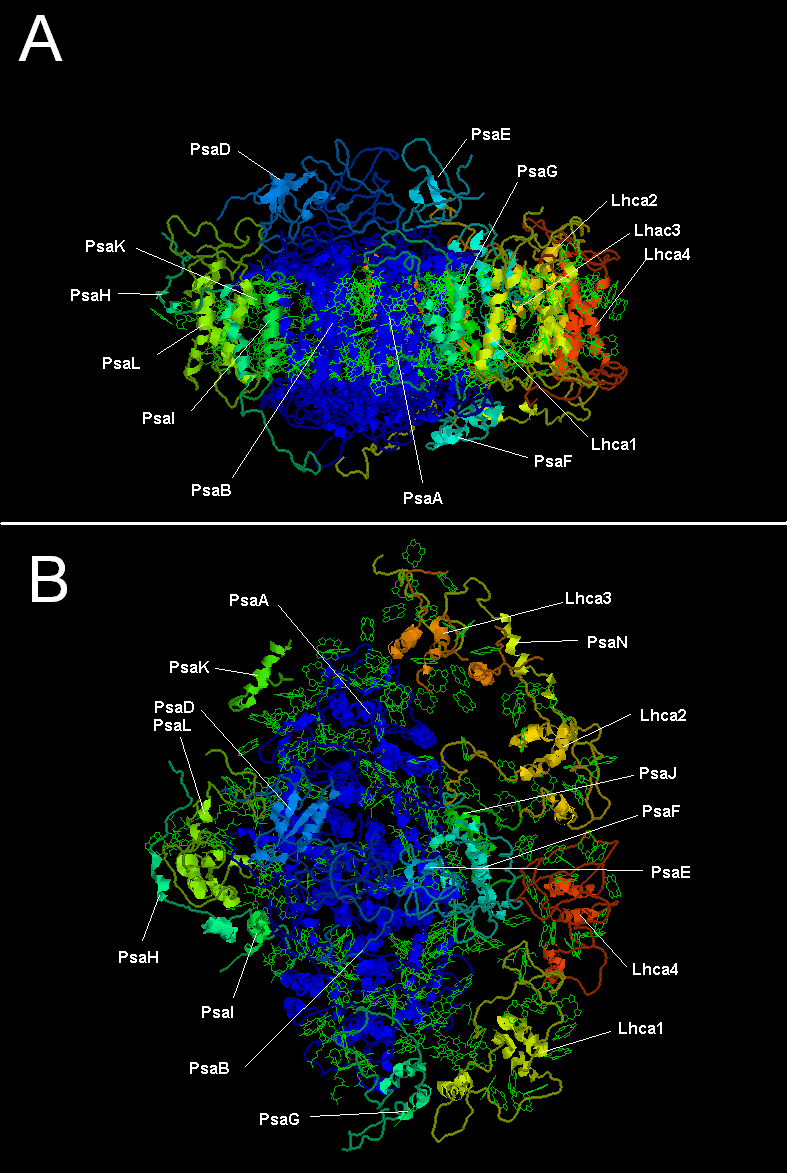Photosystem I (PSI)
Overview
Photosystem I (PSI) is the second of two photosystems, and the third of four major protein complexes in the thylakoids of cyanobacteria and chloroplasts. (A protein complex is a unit of several protein subunits.)
The thylakoids are where oxygenic photosynthesis takes place (Fig. 1).

Attribution: By Somepics - Own work, CC BY-SA 4.0, https://commons.wikimedia.org/w/index.php?curid=38088695
The other photosystem, photosystem II (PSII), is the first of the four and was described here and here.
Despite being the second photosystem, PSI was the first discovered and hence its name. Both photosystems were discovered in the 1950s but their functions not pieced together until 1961. (By geniuses, in my opinion!)
Another name for photosystem I is plastocyanin–ferredoxin oxidoreductase, and we’ll pick apart the significance of this in the next chapter. But just from the previous chapter, where we discerned the meaning of plastoquinol-plastocyanin reductase, you may have already recognised the ‘-ase’ ending signifies an enzyme (a protein which acts as a catalyst) — and that the ‘oxidoreductase’ part just may have something to do with reduction and oxidation…
Photosystem I (PSI)
As mentioned above, PSI is a protein complex, a structure composed of several protein subunits. Fig. 2 below shows both the protein complex which is PSI (with ‘Psa’ prefixes) and the associated light-harvesting complex (LHC) which collects photon energy (with ‘Lhc’ prefixes):

A and B are different orientations
'Psa' prefix: Photosystem I proteins
'Lhc' prefix: Light-harvesting complex proteins
Attribution: Эрг, CC BY-SA 4.0 , via Wikimedia Commons
Comparison with Photosystem II
One interesting comparison between the two photosystems concerns their origins. PSII is only found in oxygenic photosynthesisers — those which can split water, which are all cyanobacteria, algae and plants. This suggests an evolutionary origin of PSII in cyanobacteria, which appeared much later than other photosynthesising bacteria (all anoxygenic photosynthesisers), and which are also believed to be the ancestor of modern chloroplasts.
PSI, on the other hand, has many molecular similarities with the photosystems of the green sulfur bacteria, which are all anoxygenic photosynthesisers. Anoxygenic photosynthesisers all have one photosystem only — perhaps whichever organism branched off and evolved a second one became the ancestor of the first cyanobacterium?
However each came to be, both PSII and PSI are the only two of the four protein complexes in oxygenic photosynthesis which can absorb photons. This makes them the only two of the four which can participate in the so-called light-dependent reactions of photosynthesis — those requiring a photon input.
Both photosystems have a light-harvesting complex (LHC) and a reaction centre. Only PSII has a third component, the oxygen-evolving complex (OEC), which splits water.
The Light-Harvesting Complex (LHC)
The role of each photosystem’s light-harvesting complex (LHC), or antenna complex, is to channel photon energy to each photosystem’s reaction centre.
As with PSII, PSI also contains photosynthetic pigments able to absorb photons over a range of wavelengths. These are chlorophylls, xanthophylls and carotenes.
The Reaction Centre
Each photosystem contains a reaction centre made of two specialised chlorophyll-protein complexes acting as one unit. The reaction centre of PSII is called P680, and that of PSI is P700. ‘P’ in both instances stands for ‘pigment’, and the number refers to each one’s maximum absorption wavelength: P680 at 680 nm and P700 at 700 nm. Not only does each photosystem harvest photon energy channelled from the antenna complex into the reaction centre, each can also absorb light photons directly: PSII via P680 and PSI via P700.
The photon energy PSII and PSI harvest stimulates an electron in P680 and P700 respectively to a very excited state, which is then ejected. This highly-excited electron initiates a series of electron-transport chain reactions which drive other reactions.
Roles
PSII has two roles. One is to harvest photon energy and initiate photosynthesis by ejecting a highly-excited electron which enters an electron-transport chain. The other role is to split water so as to replace the ejected electrons whilst simultaneously freeing up hydrogen ions (protons). These protons go on to enter other reactions which generate energy other cells can use. This energy is called ATP (adenosine triphosphate), and we’ll cover all of this in a later chapter.
PSI has a different purpose. It uses harvested photon energy to transfer the excited electrons originally from PSII across the thylakoid membrane, from the inside of the thylakoid (the lumen) to the outside (the stroma). These electrons are needed to make the electron carrier NADPH (nicotinamide adenine dinucleotide phosphate), and again something to cover in a later chapter.
Further Electron Flow
Photosystem I is the third of four major protein complexes in oxygenic photosynthesis, and yet so far we have only covered the photon energy harvested by both PSII and PSI, with barely a mention of the electrons which have flowed into PSI via PSII and cytochrome b6f complex, nor of the proton production along the way and their role still to come.
Those electrons and protons are about to feature in some very important reactions. The protons must wait for their own chapter, but in the next chapter we will follow the electron flow across the thylakoid membrane, from the lumen to the stroma, via photosystem I.
About the Author
BSc(Hons), U.Syd. - double major in biochemistry and microbiology, with honours in microbiology
PhD, U.Syd - soil microbiology
Stumbled into IT and publishing of all things.
Discovered jujube trees and realised that perhaps I should have been an agronomist...
So I combined all the above passions and interests into this website and its blog and manuals, on which I write about botany, soil chemistry, soil microbiology and biochemistry - and yes, jujubes too!
Please help me buy a plant if you found this article interesting or useful!